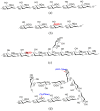Overview on biological activities and molecular characteristics of sulfated polysaccharides from marine green algae in recent years
- PMID: 25257786
- PMCID: PMC4178480
- DOI: 10.3390/md12094984
Overview on biological activities and molecular characteristics of sulfated polysaccharides from marine green algae in recent years
Abstract
Among the three main divisions of marine macroalgae (Chlorophyta, Phaeophyta and Rhodophyta), marine green algae are valuable sources of structurally diverse bioactive compounds and remain largely unexploited in nutraceutical and pharmaceutical areas. Recently, a great deal of interest has been developed to isolate novel sulfated polysaccharides (SPs) from marine green algae because of their numerous health beneficial effects. Green seaweeds are known to synthesize large quantities of SPs and are well established sources of these particularly interesting molecules such as ulvans from Ulva and Enteromorpha, sulfated rhamnans from Monostroma, sulfated arabinogalactans from Codium, sulfated galacotans from Caulerpa, and some special sulfated mannans from different species. These SPs exhibit many beneficial biological activities such as anticoagulant, antiviral, antioxidative, antitumor, immunomodulating, antihyperlipidemic and antihepatotoxic activities. Therefore, marine algae derived SPs have great potential for further development as healthy food and medical products. The present review focuses on SPs derived from marine green algae and presents an overview of the recent progress of determinations of their structural types and biological activities, especially their potential health benefits.
Figures





References
-
- Guerra-Rivas G., Mariana Gomez-Gutierrez C., Alarcon-Arteaga G., Esthela Soria-Mercado I., Ernestina Ayala-Sanchez N. Screening for anticoagulant activity in marine algae from the Northwest Mexican Pacific coast. J. Appl. Phycol. 2011;23:495–503. doi: 10.1007/s10811-010-9618-3. - DOI
-
- Kim S.K., Li Y.X. Medicinal benefits of sulfated polysaccharides from sea vegetables. Adv. Food Nutr. Res. 2011;64:391–402. - PubMed
Publication types
MeSH terms
Substances
LinkOut - more resources
Full Text Sources
Other Literature Sources

